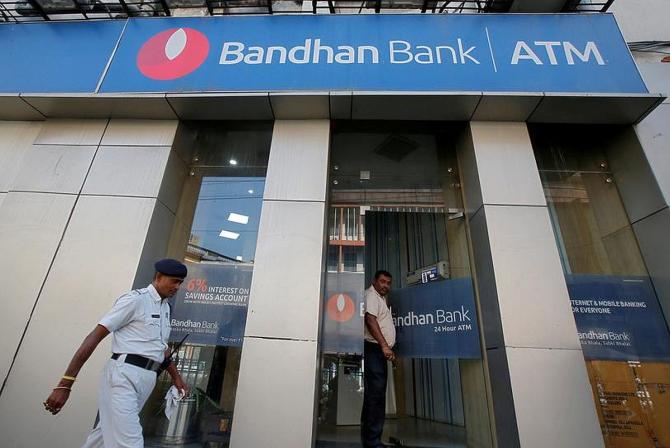It is 10 years since Bandhan Financial Services became the first microfinance institution (MFI) to receive the universal bank licence.

A year later, in 2015, it started operations.
Bandhan’s entry into banking was seen as a vote of confidence by the Reserve Bank of India (RBI) for the country’s microfinance sector.
Subsequently, the RBI awarded small finance bank licences to nine MFIs.
For any microlender that evolves into a bank, the challenge is how to quickly diversify the loan book to include a higher share of secured loan.
Microloans are unsecured. Conscious of this, the Kolkata-based Bandhan acquired affordable housing finance company Gruh Finance in 2019 from what was then HDFC Ltd.
This helped it to increase the share of its secured loan book.
The bank’s unsecured book, however, is still heavy at 55.5 per cent. Asset quality concerns over these unsecured microloans have returned.
Asset quality and NPA concerns
Before the Covid-19 pandemic struck, the bank’s gross non-performing assets (NPAs), as a percentage of gross advances, were below 2 per cent.
During the pandemic years, the gross NPA ratio shot up: to 6.81 per cent in 2020-21 (FY21) and 6.46 per cent in (FY22) from 1.48 per cent in 2019-20 (FY20).
The bank managed to bring it down to 4.87 per cent in FY23.
This financial year, though, the gross NPAs are on the rise again.
They shot up to 7.3 per cent towards the end of September, before slipping slightly to 7 per cent by the end of December, courtesy an NPA sale to asset reconstruction companies (ARCs).
“Slippages were elevated (essentially in Emerging Entrepreneur Business, or EEB), with potential one-offs from system migration issues, but sale to ARCs has pushed down GNPLs/NNPLs (gross/net non-performing loans) to 7 per cent/2.21 per cent versus 7.32 per cent/2.32 per cent in Q2FY24.
"Despite this, the stress pool was sticky at 14.4 per cent (QoQ), indicating continuing forward flows,” Elara Capital said in a note post the October-December earnings.
EEB, which is essentially the microloan portfolio, includes loans to both groups and individuals.
The third quarter saw EEB slippages of Rs 993 crore, 45 per cent of which were due to the migration to a new core banking system platform in October.
Then came festival-related holidays, which typically impact loan repayment collections, the bank said.
During an interaction with analysts, Chandra Shekhar Ghosh, managing director and chief executive officer of Bandhan Bank, said the slippages had reduced in November and December.
He assured that these would decline further in the months to come.
In a note after the Q3 earnings, brokerage house Anand Rathi said, “Slippages are a high Rs 13.9 billion (5.4 per cent of loans), of which Rs 9.9 billion stemmed from the EEB book.
"[The] management stated that the slippage run rate sharply improved in December 2023, indicating lower stress formation.”
EEB forms roughly 50 per cent of Bandhan’s total loan portfolio — down from 54 per cent in December 2022 and 65.4 per cent in December 2021.
The bank has clarified that 85 per cent of loans in the EEB book had been extended in FY24. Only 0.11 per cent loans disbursed this financial year, it said, had slipped to the non-performing category.
The days per due parameter had also shown signs of recovery. (Days per due is the number of days by which a borrower has missed an EMI payment.)
Repayment overdue for 61-90 days had fallen from Rs 720 crore in the June quarter to Rs 530 crore in December.
Repayment overdue also improved in the 1-30 days and 31-60 days categories between the April-June and October-December periods.
While the bank has brought down its dependence on the overall ECB portfolio, within it, EEB group loans, too, are expected to fall — from 33 per cent of the overall loan portfolio to 26 per cent by 2026, mainly because of other loans recording stronger growth.
Geographical diversification is also in focus, with the EEB portfolio from West Bengal and Assam falling below 45 per cent.
Focus on NIMs
Investors are also keeping a close eye on net interest margins (NIMs) since the bank raised deposits at a higher rate amid tight liquidity in the banking system.
The liquidity of the banking system, which shifted to a deficit in September, persisted throughout the October-December quarter.
“The incremental bulk deposits were raised at a higher rate of 8.1 per cent in 3QFY24 and the full impact of the same is expected to be seen in 4QFY24,” broking house Nirmal Bang said.
The bank’s NIM remained largely stable on a sequential basis at 7.2 per cent in Q3FY24.
Loan growth for the lender has continued to be robust with advances growing 7.7 per cent sequentially in the third quarter and 18.7 per cent year-on-year to Rs 1.16 trillion as on December 31, 2023.
In fact, the loan book has more than doubled since FY19, from Rs 44,776 crore.
“Q3 saw better growth momentum, with 8 per cent QoQ loan growth and better growth across segments. Q4 being a strong quarter, expect growth momentum to improve,” the Elara note said.
The CEO’s term
The one person who has been part of the bank’s journey from the starting line is Ghosh, its CEO.
He has led Bandhan since its inception, but his term ends on July 9.
Last year, the board had approved his reappointment for three years.
The RBI’s approval is awaited. This is another aspect that investors are tracking closely.
Broking firm Nirmal Bang had said that clarity about the status of an extension to Ghosh is a reason why the stock of Bandhan Bank will see an overhang in the near to medium term.
In recent times, the regulator has been strict about extending the term of bank CEOs.
A few years back, the RBI extended then RBL Bank MD and CEO Vishwavir Ahuja’s term for just one year, sending a clear signal that the lender needed to find a new leader.
Last year, the term of IndusInd Bank’s MD and CEO was extended by only two years though the board had approved a three-year extension.
And this year, the RBI denied Federal Bank MD & CEO Shyam Srinivasan’s extension for one year even if he was eligible.
According to RBI’s recent norms, a CEO can serve up to 15 years.
Srinivansan will complete 14 years this year.
Asked whether the bank has received any communication from the regulator on his extension, Ghosh told Business Standard: “It is not right to comment on the issue.
"My focus is business, compliance, mitigating risk, and good governance.”
A decade after it became a full-fledged bank, Bandhan would want to be seen as a success story.
Disclaimer: This article is meant for information purposes only. This article and information do not constitute a distribution, an endorsement, an investment advice, an offer to buy or sell or the solicitation of an offer to buy or sell any securities/schemes or any other financial products/investment products mentioned in this article to influence the opinion or behaviour of the investors/recipients.
Any use of the information/any investment and investment related decisions of the investors/recipients are at their sole discretion and risk. Any advice herein is made on a general basis and does not take into account the specific investment objectives of the specific person or group of persons. Opinions expressed herein are subject to change without notice.










